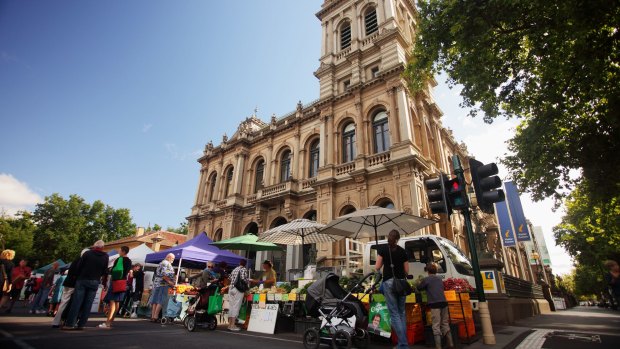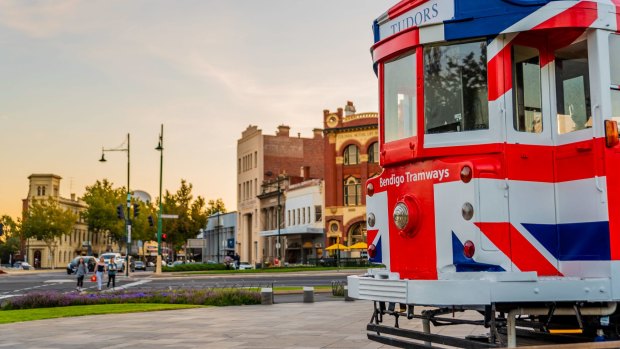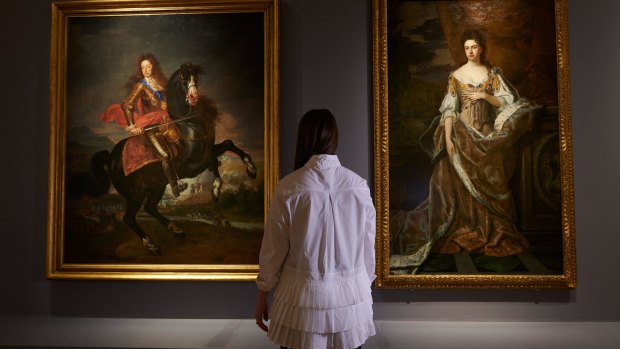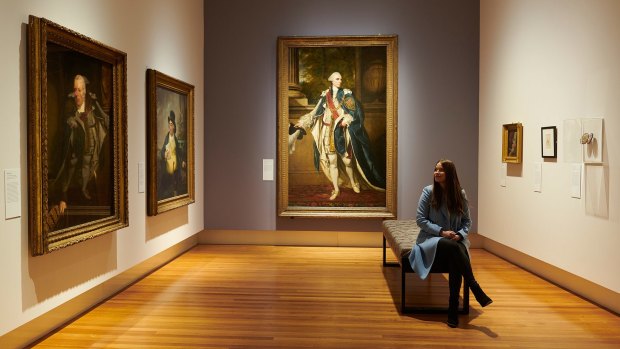This was published 5 years ago
Bendigo things to do on a weekend away: Getting the royal treatment
By Tim Richards

A minimum of 75 per cent of traders at the monthly Bendigo Community Farmers' Market sell local produce.
I wasn't expecting to be having dinner with the Queen on a Friday night, and especially not in Bendigo.
Over years of travel I've become comfortable with solo dining, and being at a table for one is no burden at The Dispensary. In the compact interior of this laneway restaurant, I'm working my way through tasty dishes and an interesting drinks menu (a "broad-spectrum beverage offering", jokes the waiter), when I happen to look up.
Above my table, suspended by chains within a gilt frame, is a portrait of Queen Elizabeth II. The restaurant owners aren't ardent royalists, however – it's part of a city-wide push to promote the latest exclusive exhibition at the Bendigo Art Gallery, Tudors to Windsors: British Royal Portraits.

This so-called Royal Tram commemorates the Queen's 1954 visit to Bendigo, when a special tram was decked out in red, white and blue lights.
Chatting with the couple seated next to me, I find that they're also in town for the exhibition, which was sourced from the UK's National Portrait Gallery. They make a point of telling me how they were lost on a nearby street on the way to the restaurant, and a waiter came out personally to find them after they'd phoned for directions.
Bendigo, it seems, is that sort of place – big enough to have a spread of good eating and attractions, but still small enough to offer old-fashioned country hospitality.
There's enough of interest in this regional city north of Melbourne to stretch my gallery visit out to a weekend break, so I'm catching some food and culture highlights before seeing the art.

Each room at the Tudors to Windsors exhibition is devoted to a house or generation of the British royal family.
Saturday: market and music on the move
First stop is the Bendigo Community Farmers' Market, which takes place on the second Saturday each month next to Rosalind Park, the beautiful gardens which are the centrepiece of the Bendigo CBD.
A minimum of 75 per cent of its traders sell local produce, and a fine example of that commitment is Sue Gerdsen's Vintage Kitchen Preserves stall.

The Tudors to Windsors exhibition which runs until July 14 at the Bendigo Art Gallery.
"I'm trying to make as much as possible with what the world provides us," says Gerdsen. "Foraging, buying local, taking anything that's given – I cook whatever is there, so there's zero waste."
As a result, her stall is stacked with an array of preserves, including lemon butter made with fruit cadged from neighbours, a tangy turmeric and ginger spread, and her "Outback Chutney" made from an oversized zucchini grown "out the back" of her house.
A short walk away within the CBD are other food highlights including Indulge, which serves excellent sweets made from Belgian chocolate. Nearby, The Good Loaf bakes award-winning bread within a striking heritage-listed circular building which was once a tyre repair business.
Another stayer in the food scene is Bendigo Wholefoods, a no-fuss combination of plant nursery, grocery shop and cafe in adjoining premises. It's here I have lunch, a bowl of falafel served on top of creamy beetroot hummus and coconut labna, with a cous cous tabbouleh salad. Country food was never like this when I was growing up.
After lunch I board the Blues Tram. Bendigo's trams normally trundle between two tourist attractions, the Central Deborah Gold Mine and the Joss House, a historic Chinese temple. Once a month the Bendigo Blues and Roots Festival takes over one tram for an afternoon, serving drinks as musicians play and the vehicle does a slow crawl along the line and back.
Today we get to hear mellow local duo Jon and Bel on the way out, and we sip our shiraz or chardy as they sing standards such as the ballad What a Wonderful World. On the way back, Jimmy Davis strikes a sparkier note with his energetic original songs and high vocal range.
Dinner at Masons of Bendigo is another foodie highlight. This classy restaurant takes its name from the glass factory which once occupied its premises, and turns out innovative dishes with an emphasis on local ingredients. From the larger dishes I opt for the potato gnocchi with camel milk custard, though there are plenty of locally sourced meat options (including pork belly, lamb, and rib-eye) for those less vegie-oriented.
Sunday: coffee and the royals
As an entree to the big exhibition, Bendigo has another vintage tram painted in the colours and stripes of the British flag, erected within a corner of Rosalind Park. It's not subtle, but this so-called Royal Tram commemorates the Queen's 1954 visit to Bendigo, when a special tram was decked out in red, white and blue lights.
This tram has been refitted as a cafe with benches and tables, and a barista from local cafe Get Naked Espresso Bar is active over an espresso machine at one end. Near a statue of Queen Victoria and overlooking the Alexandra Fountain (named for the wife of King Edward VII), the Royal Tram is a charming pit stop for people on the way to ogle the kings and queens of past centuries.
Which is what I'm off to do now. As no fan of the monarchy I'm a little dubious about the use of the royals as celebrities, and I wonder if Tudors to Windsors will apply the unquestioning adoration sometimes found in tabloid media (when they're not tearing them down for being human, that is).
I'm pleasantly surprised to find there's a lot more to the exhibition than flattering royal mugshots over the centuries. It's a large exhibition, with copious notes and timelines to help interpret the art, and it would be easy to spend hours poring over it.
What emerges, as I progress from one room to another, is something more than a depiction of royalty in its splendour. What's also going on is a masterclass in the history of portraiture, as the highly codified formal portraits of the Tudor era give way to more informal styles of later years, and to the more complex media of the present day.
Each room is devoted to a house or generation of the British royal family, starting with the Tudors within a room with dark blue walls. Here are portraits of Henry VIII as a vigorous young man and as a dissipated old king, and of notable courtiers such as Sir Walter Raleigh and Sir Francis Drake – the latter looking every inch the official pirate he was on behalf of Queen Elizabeth I.
The Virgin Queen herself dominates the room, via the Ditchley Portrait painted in 1592 by Marcus Gheeraerts the Younger. It's a huge painting, depicting her standing upon the counties of England. It's a potent expression of royal power – but only a few metres away is the tiny suit of armour made for Elizabeth's half-brother King Edward VI, who didn't live long enough to need an adult suit.
The formality of the Tudors gives way to the louche Stuarts, with Charles II almost leering at the viewer from his slouching position on the throne. A sultry nearby portrait of the king's mistress, Nell Gwyn, amplifies the relaxed tone of his reign, and another of Queen Anne is a reminder of the recent movie depiction of her misfortunes in The Favourite.
In the section devoted to the Victorians photographic portraits first appear, along with a new emphasis on the monarch's family, suggesting the appeal of the monarchy as a symbol of stability in changing times.
The section devoted to the Windsors, spanning the early 20th century to the present day, displays a fascinating selection of formal and informal depictions, encompassing such diverse episodes as the abdication of Edward VIII and the glamour of Princess Diana. A more prosaic painting depicts King George VI having afternoon tea with his wife and kids.
In the final room, two images of the Queen – one a lenticular portrait of her with eyes shut, the other a colourful reworking of a photo by Andy Warhol – suggests how far the monarchy has come from the exercise of pure political power. Over the centuries it's transformed into something purely symbolic that's hard to pin down, though this exhibition encourages you to try.
TRIP NOTES
MORE
FLY OR RIDE
Qantas flies from Sydney to Bendigo. See qantas.com.au
Alternatively, Bendigo is two hours from Melbourne by train. See vline.com.au
STAY
Quest Schaller Hotel Bendigo offers compact, stylish rooms near the city centre. From $135 a night. See questapartments.com.au
Balgownie Estate has a good restaurant, luxury rooms and "glamping" tent accommodation in an attractive winery setting, from $150 a night. See balgownieestatebendigo.com
SEE
The Tudors to Windsors exhibition runs to July 14, 2019, entry $25. Book via bendigoartgallery.com.au
The Blues Tram costs $35, book via bendigotourism.com/bendigo-blues-tram
Tim Richards was a guest of Bendigo Tourism.
Sign up for the Traveller Deals newsletter
Get exclusive travel deals delivered straight to your inbox. Sign up now.